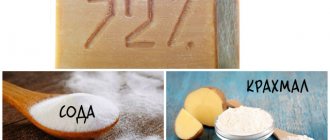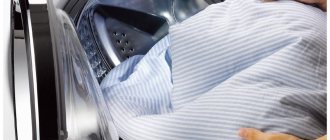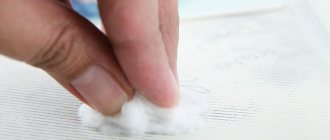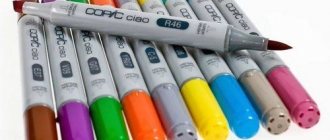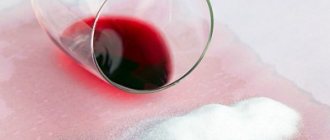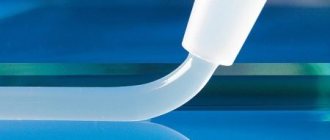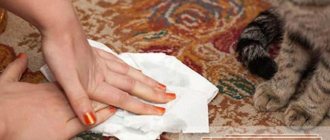How to wash tea from white and colored clothes - this question is most likely asked by every second inhabitant of the planet. Of course, after all, tea is one of the most frequently consumed drinks, and putting a stain on it is not surprising. Therefore, you should figure out how to remove tea stains on white or colored fabric. Both traditional methods and household chemicals will help you cope with this unpleasant problem.
Proper removal of tea stains is a common question, because knowing the answer, you can avoid an unpleasant situation and save your favorite item from going into the trash. Both special substances and the simplest ones, which are present in every home, will help solve the problem.
Every tea lover knows the problem of unsightly brown marks on the inside of the cup. If the coloring substances of the drink are able to penetrate into the top layer of ceramics and glass, what can we say about fabrics: tea leaves very “corrosive” and difficult to remove stains on clothes.
The culprit is tannins – tannins, a large amount of which is found in tea leaves. Tannins quickly stain the fibers of fabric or paper, but removing brown pigment from a soiled item will not be easy - the molecules are hidden deep in the structure of the material.
Comment! Traces from light green tea are even more difficult to remove than from black tea. The reason for this strangeness lies in the same tannins: green tea leaves contain several times more tannins.
Having spilled their favorite drink on a blouse, jeans, tablecloth or sofa, many immediately part with the item. There is no need to rush – you can fight tea stains at home. Fresh marks are washed off much easier. The simplest case is newly “planted” tea stains on a white plain item. But you can also try to remove old tea stains. There are several truly effective ways to combat stains even on colored and synthetic clothing.
Features of removing tea stains
If you have just spilled tea on your clothes, you should immediately soak the item in warm water. As long as the stain is not dry, it can be simply removed with regular laundry detergents (laundry soap, washing powder, stain remover).
When there is no opportunity to remove and wash clothes (while at work, at a party), you can try an express method: medical alcohol. Soak a cotton pad in a small amount of alcohol and gently blot the tea stain. At the same time, alcohol molecules mix with tannin particles and, evaporating, take most of the dye from the fabric fibers.
Advice! If pure alcohol is not on hand, express cleaning can be done using vodka or alcohol-based wet wipes.
Washing machine help
To deal with dirt as quickly as possible, you can use a washing machine. Instead of the usual powder, in this case it is necessary to use a special product. A good way to deal with tea stains is to use a product containing bleach. The drug is poured instead of washing powder and oxalic acid is added.
If you are not confident in your own abilities, it is better to turn to professionals. In this case, a positive result is guaranteed
How to wash black tea
As already mentioned, tea differs from tea to tea. Therefore, stains from green and black drinks will have to be removed differently. So, you can try to wash black tea from clothes with any stain remover. When choosing a product, you must take into account the composition of the fabric: it is advisable to wash colored and synthetic items in an oxygen stain remover (it does not contain chlorine).
Stains left long ago by black tea are practically impossible to remove. They may lighten, but will not disappear completely. The situation is especially aggravated by ironing clothes: if an item with remaining stains is ironed with a hot iron, tea particles are “preserved” in the fibers of the fabric. In such situations, only wisely chosen folk remedies can really help.
Tips and tricks
Any marks remaining after tea drink gets on white textiles will be removed faster if you immediately wash the product in warm water and soap.
If it is not possible to wash immediately, it is recommended to blot the stains with alcohol. After some time they are easily wiped off.
When eliminating a stain, all actions are carried out in the direction from its periphery to the center. This prevents contamination from spreading. A white cloth or paper napkin is placed under the fabric and replaced periodically.
After performing any cleaning actions, things must first be rinsed. After this procedure, they can be placed in the machine drum for subsequent washing.
Tea stains on a snow-white product do not look aesthetically pleasing and require quick action. It is important to select suitable products to solve this problem, focusing on the type of fiber. This will avoid deformation of the fabric.
Removing tea stains using folk remedies
If there is no stain remover in the apartment, products from the first aid kit and food products will come to the rescue. Traditional methods are no less effective than household chemicals.
How to remove tea stains from white clothes with boiling water
Treating fabric with boiling water helps remove stubborn tea stains. Place the white item in a basin and pour boiling water over the stains thoroughly, and then leave to steam for 10-15 minutes under the lid. After this, the clothes need to be loaded into the drum of the washing machine and washed with a small amount of regular powder.
Boiling water is very effective at removing tea stains, but when using it you need to remember two important nuances.
- Boiling water treatment can only be used for cotton and linen fabrics; if the item is made of wool or synthetic material, hot water will deform it and ruin it.
- Boiling water is only safe for relatively new and durable white items. It is not recommended to wash old tablecloths and items of clothing in this way - the fabric will become even thinner and dilapidated.
Another rule when treating with boiling water is that before removing a stain using extremely hot water, the soiled fabric must first be soaked in cool water with soap added. The stain will become less persistent, and boiling water will be able to remove it completely, but if you pour hot water on the newly stained stain, the effect may be the opposite
Salt and glycerin
Mix the ingredients until mushy and apply to the stain. To eliminate it completely, you should wait a few minutes. After getting rid of the stain, wash the item as usual.
Glycerin and ammonia
You will need 1 tbsp. l. glycerin and ¼ tsp. alcohol Mix, apply to dirt, rub in gently. Afterwards, wash the item thoroughly.
Oxalic or citric acid
For 250 ml of water take 2 tsp. citric acid. Soak a clean sponge in the mixture and gently rub the stain. Oxalic acid has a similar effect, but you need to take 1 tsp per glass of cold water. Then wash the clothes using the usual method.
Lemon juice
Divide the citrus into two parts and squeeze the juice directly onto the dirt. The dyed area is bleached, then the clothing is washed.
Ammonia
For white products, you can use alcohol. Place a light napkin or towel under the stain and moisten the stains on top with ammonia. Wait an hour, then wash.
Hydrogen peroxide
The product is used for delicate fabrics. Soak cotton wool in peroxide and clean your clothes with it. Then wash at cold temperature.
Application of peroxide:
- Apply a little peroxide to a cotton pad and clean the dirty area.
- Leave for 10-15 minutes.
- Wash the item.
Peroxide can be combined with ammonia:
- Clean the tea stain with diluted peroxide and a drop of ammonia.
- Rinse thoroughly with clean water and detergent.
- Dry.
Ammonia and peroxide
Mix the ingredients in a 1:1 ratio. Wipe off the stain and wash the item until it loses the smell of alcohol.
Bleaching
This is an aggressive method, suitable for white cotton. Other natural materials may deteriorate. Apply the product, wait a few minutes, wash.
Lemon juice, salt and borax
The mixture will cope even with old stains. Dilute borax in one bowl, and in another make a paste of juice and fine salt. First, let the borax sit on the dirt for a few minutes, then treat it with a mixture of citrus and salt. You can perform several approaches until the streaks are completely eliminated. Then you need to wash the T-shirt.
Lactic acid and borax
The method is similar to the previous one, only after treatment with borax you need to wipe off the dirt with lactic acid.
Glycerol
Apply warm solution to stained wool or silk. After a quarter of an hour, treat the contaminated area with warm, clean water and blot with a napkin.
Lactic acid
Another method is to mix water with lactic acid. Moisten the dirt, wait 20 minutes, rinse the item in cool water.
Removing stains from colored fabric
Tea staining colored clothing is a more complex problem than tea stains on light-colored items. To remove such stains, you need to take care not only that the fabric becomes clean again, but also that it does not lose its original shade, otherwise it will be impossible to save the item of clothing.
Therefore, to clean colored items, you should choose products with a mild effect, for example, borax. In the pharmacy this remedy can be found under the name sodium tetraborate. To remove dirt, you will need a 10% borax solution, which must be diluted with water in a 1:1 ratio. Then you need to moisten a cotton pad with the resulting liquid and remove tea stains with it, then rinse the item under running water.
A weak solution of vinegar will help remove traces of tea on colored items. The product must be diluted with water in equal proportions, applied to the contaminated area and lightly rub the stain. After this, you can wash the clothes by hand or put them in an automatic wash by adding a suitable detergent.
If the stain is completely fresh, you can carry out “emergency” removal of tea marks. To do this, stretch a cloth with tea stains over a basin or bucket and pour boiling water on top, with a hot stream of water hitting the stain directly. Then you need to wash the item completely using soap. This method is only suitable for non-fading colored cotton fabrics.
For old stains you need a more powerful product. You can remove such stains with lemon juice: carefully apply citrus juice to the stain, after holding the item over a container of boiling water. After this, the clothes must be washed so that the fruit does not leave its traces instead of tea marks.
How to remove green tea stain
Household stain removers have virtually no effect on old green tea stains. You can remove such a tea stain from clothes only with a reliable folk remedy:
- Take a tablespoon of glycerin and table salt (coarsely ground).
- Mix the ingredients so that you get a homogeneous paste.
- Apply the product to the tea stain and leave for 30-40 minutes.
- If the material allows, you can gently rub the contaminated area with a brush.
- Rinse off the glycerin and salt and wash the item as usual.
This folk remedy is used carefully, as it can discolor not only the stain, but also the pattern on the fabric. You shouldn’t put too thick a layer of slurry on the tea mark - a couple of millimeters is enough!
Removing old stains
Anything can happen in life, but there are always ways out of this “anything.” When any force majeure situation did not allow you to immediately get rid of tea stains, and now you do not know how to remove tea stains, because they are dying and do not want to go away, then there are still options for salvation in this situation. They will be discussed below.
White things
Our grandmothers and great-grandmothers knew how to remove tea stains from white clothes, and the experience of modern housewives did not disappoint. Therefore, we offer both traditional and modern methods of cleaning undyed matter.
Chlorine
“Belizna”, “Clorox” and other chlorine-based products have long been used for bleaching. If the item is not synthetic, then nothing bad will happen to it after such treatment. Calmly do the job, using the instructions, and you will clean your product - it will be very easy to remove tea from white things.
“Domestos”
A very strong product that is intended for cleaning toilets and sinks, but also works on fabrics made from natural materials. How to remove tea stains on white clothes with Domestos? Use promptly, do not delay the effect on the fabric over time - apply a drop of the substance and rinse off after five minutes. Believe me, this is enough to completely get rid of pollution.
Oxalic and citric acids
These components belong to the class of clarifiers, not bleaches, which, in principle, is also excellent for our task - how to wash tea from white tea. You need to do the following:
- Mix both acids - two parts oxalic to one part citric.
- Apply the mixture directly to the dry stain, without wetting, from the edges to the middle.
- When you see that the tea stain is gone, remove the remaining acids and wash the item.
Hydrogen peroxide and ammonia
These two elements work according to the same scheme. How to remove tea stains on white clothes using these two alcohols:
- Prepare a solution in the proportion of a liter of water + one teaspoon of one or another alcohol.
- Soak the product in it for two to three hours.
- After the stains have disappeared, wash the clothes as usual.
If you don’t want to wash the item, you can try to remove only the trace of the drink. You need to moisten the stain directly with a solution of one of the alcohols, one part alcohol to two parts water, and wait until it disappears.
Supra
If you are a “natural” blonde who dyes your hair at home, then your supra (in other words, hair lightener), which you probably have on hand, will help you solve the problem of how to remove tea from white things. Make a weak mixture and apply to the stain.
Colored clothes
You probably know that dyed material can fade when washed. How to remove a tea stain on colored fabric is not an easy task, because the means and methods must be gentle, but at the same time, effective. There are such people.
Glycerol
So, in order to remove a stain from a colored item using glycerin, you can use several options:
- Heat ordinary liquid glycerin, sold in any pharmacy, to about forty degrees, apply it to the flaw using a sponge. After fifteen minutes, remove the substance and wash the product.
- Mix salt and glycerin to a non-liquid paste and apply this mixture to the stain. After twenty minutes, remove the mixture from the stain and wash the item.
- Soak a cotton swab in the following solution: two tablespoons of glycerin and one drop of ammonia, wipe the flaw with this solution until it comes off completely. Then it is advisable to wash the entire product too.
Lemon acid
An excellent and very gentle method for removing tea stains from colored fabric. You need to prepare water in a basin with citric acid dissolved in it - a spoonful of powder per liter of water:
- Soak damaged clothing in this water.
- Keep it like this all night, and squeeze it out the next morning.
- Next, wash in water and powder as usual, or in a washing machine if you have accumulated enough dirty clothes.
For any type of fabric
There are fabrics that do not fit into the above categories: silk, chiffon and other delicate materials. Therefore, for such things there are very gentle methods for removing old tea stains.
Lactic acid
Perfect for the most delicate materials. Need to:
- mix acid and water in equal proportions;
- place the item in the solution for twenty minutes;
- then - no need to wash, just rinse the product in water at room temperature.
Borax
In scientific terms, it is the sodium salt of boric acid. Sold in pharmacies without a prescription and helps housewives in removing various contaminants. Removing tea stains with this product is simple:
- Mix borax and water one to one.
- Soak things for several hours.
- Wring out and wash the items.
Tea stains on various fabrics
Stain removal methods for different fabrics will vary, as will the washing itself. Do not rush to remove the stain using an inappropriate method, so as not to ruin the item altogether.
Delicate fabrics (silk, wool)
Here we will do without boiling water, contrast rinsing, aggressive washing and chlorine-containing bleaches. Only mild impact: glycerin, lactic acid, borax, lemon juice, soap or a gentle stain remover.
Tip Test the product on an inconspicuous area of clothing. Unfortunately, we spill tea in the most visible place.
How to remove tea stains in a washing machine
Each type of fabric has its own characteristics that you should pay attention to when washing and cleaning stains, including tea stains. An automatic washing machine will help you deal with such a nuisance as tea stains on clothes if you don’t have time to scrub them off by hand. But it is important to know how to wash this item correctly in order to remove the stain without ruining it.
Using machine washing, it’s easy to remove tea stains from items of any color and any fabric.
15 minutes before washing colored items, pre-apply heated glycerin to the stain.
Table: machine settings and means for removing tea stains from different types of fabric
| Fabric type | Mode/temperature/spin speed | Detergent options |
| White cotton or linen | Quick wash + rinse / 40° C / 1000 rpm |
|
| Colored cotton or linen | Quick wash + rinse / 40° C / 1000 rpm |
|
| Synthetics | Pre-wash + quick wash + rinse / 40° C / 900 rpm |
|
| Wool | Quick wash + rinse / 40° C / 900 rpm |
|
| Colored fabrics of any type (not delicates) | Pre-wash + quick wash + rinse / 40° C / 1000 rpm |
|
| Delicate fabrics | Quick wash + rinse / 40° C / 700 rpm |
|
Important! Borax (sodium tetraborate) is not suitable for washing children's clothes and clothes of people prone to allergies.
Rules for removing stains
When liquid gets on the fibers of clothing, carpet or furniture, housewives try to immediately wash and remove the stain
An important condition is not to delay the problem, fresh is easier to remove
From clothes
The sooner a stain is detected, the greater the chance of removing it. Fresh dirt should be placed in a soap solution and rubbed with a brush. If you can’t start washing right away, treat the stain with alcohol.
Stain removers work well with outdated marks:
- use products according to the color of the product. White linen products contain chlorine, which corrodes the pattern;
- carefully read the instructions for the stain remover: not all manufacturers recommend soaking items before washing;
- Apply stain remover along the edges, gradually approaching the center of the stain. This will prevent spreading;
- when processing, place a white cloth underneath, this will prevent damage to clean clothes;
- When washing, add more product.
If there is no stain remover, available products will help:
- Apply heated glycerin to the green tea stain;
- glycerin with salt or ammonia. Mix the components (ratio 1:1) and place in soapy water. Soak the soiled tablecloth for half an hour in a basin, then wash and rinse;
- use citric acid diluted with water or lemon juice;
- Rinsing in water with lactic acid for 20 minutes will help clean stained jeans;
- Stains from any type of tea: black, green or hibiscus can be easily removed with table salt. As soon as contamination is discovered, cover it with salt; it will quickly absorb the tannin. Then shake it off and wash the item;
- soak the product in warm water for half an hour, treat the stain with soda. After rinsing, the blouse will become snow-white;
- For marks on white fabrics, use ammonia, hydrogen peroxide and bleach. Keep the products on contaminated clothing for at least 20 minutes;
- things that get dirty most often - aprons, kitchen towels - rinse alternately in hot and then in cold water;
- mix borax and glycerin in a 1:1 ratio;
- soaking in boiling water helps to get rid of stains on a white jacket;
- If the above methods do not help, oxalic acid (sold in hardware stores) will help to wash the tea. Soak clothes for no more than 20 minutes; oxalic acid is an aggressive chemical.
Before using the listed products, do a test - apply them first to a less noticeable area of clothing.
Stains can also be removed using bleaches:
| Bleach type | Properties | Dosage regimen |
| Oxygen | Suitable for all types of fabrics, for white and colored linen. It will help remove stubborn tea marks. Disadvantage: short shelf life; active ingredients lose their ability to whiten. | 150 ml. for 10 liters of water. |
| Optic | The contamination is masked rather than removed. Use in combination with stain removers. | 150 ml. for 10 liters of water. |
| Chlorine-containing | Use on plain fabrics without patterns. The product works in cold water. The disadvantage of bleach is its aggressive effect on fabric and the smell of bleach. Do not use the product to bleach fur, wool, silk, or leather. | Use 2 tbsp. chlorine bleach per 1 liter of water. Soak for 20 minutes and wash the clothes. |
Wear rubber gloves when handling bleach. If the chemical comes into contact with mucous membranes, rinse with plenty of cool water.
Furniture
For cleaning upholstery of upholstered furniture and mattresses:
- Blot the stain with a napkin.
- Prepare the solution: 1 tbsp. l. Dilute dishwashing detergent with 1 tbsp. water. Pour the resulting liquid into a spray bottle. Spray the product onto the stain, then wipe the desired area with a soft sponge, collecting moisture.
- Rinse with clean water and apply an absorbent napkin or cloth.
- If the contamination is not removed, further processing must be continued. To do this, prepare a solution: mix table vinegar with water in a 1:1 ratio. Apply the solution to the fabric and leave for 10 minutes. Rinse with clean water using wipes.
Carpets and bedspreads
Depending on the color of the carpet and rug, the following products are used:
- Bleach and oxalic acid will help remove stains from black tea on white;
- for non-ferrous materials: citric, acetic acids, heated glycerin, ammonia.
The following method will help to remove ingrained traces of tea from carpet: mix vinegar, detergent, water (1:1:2). Rub the product in and then leave for 10 minutes. Then wipe with a dry cloth. Repeat as needed.
Removing old tea stains
Although a dried tea stain is more difficult to remove than a fresh one, do not despair. It is recommended to use ready-made cleaners. But it is necessary to take into account that they are available for both colored and white fabrics. This should not be neglected, otherwise, due to the high content of caustic substances in bleaches, colored clothes may change color, that is, fade.
You need to carefully study the instructions. Manufacturers always advise how best to use their product: pre-soak the contaminated area of fabric in it, or apply it directly to the stain.
Once the cleaning agent is applied, you need to wait about an hour and then wash the clothes in the washing machine. You can also add a little more cleaner during washing to make the stains more likely to disappear.
After this, all that remains is to rinse and dry the clothes.
Household chemicals
The fastest method of removing stains is soaking in special products. Good reviews from: Amway, Vanish, Antipyatnin. They do an excellent job not only of tea stains, but also of other pollutants.
- Bleach is available not only for white fabrics, but also for colored ones. Among budget options, manufacturers offer products that contain chlorine. They also remove marks well and are also gentle on the canvas.
- Cleaning. You can replace the expensive stain remover with a regular sink preparation. Domestos, for example, will perfectly remove stains on a white canvas. But when conducting such experiments, be sure to test on a less visible area first.
- Stain removers are the most common method of removing various stains from fabric. Apply to the problem area, leave for a while and then wash off with detergent.
Universal methods. Soap, salt or sugar
There are several methods that anyone can use, because the chemicals used in them are found in every home. They cannot be compared to ready-made cleaners in terms of speed of action, but they are also quite effective at removing tea stains.
The easiest way is to use white laundry soap. There are several options here:
- You can rub it on the contaminated area and gently rub it with a soft brush.
- Make a soap solution and soak the fabric in it. Then simply rinse to remove any remaining soap.
The choice here will depend on the degree of contamination. Alternatively, you can use salt or sugar. To do this, you need to cover the stain, after rinsing it, with the selected ingredient and after an hour, rinse everything off with warm water.
How to remove old marks using household chemicals
Excellent removal products are household chemicals. There is an impressive assortment of them on store shelves that it’s even difficult to choose something specific. The following can help you remove stains:
- “Amway” - for removing the most difficult stains from various fabrics;
- “Vanish” is a budget gel-like product that perfectly fights stains. There are options for both white and colored linen;
- “Anti-Pyatnin” - will help remove newly appeared traces of tea;
- Bleach can only be used on white fabrics.
If you need to clean the carpet, we have already described proven methods in detail!

